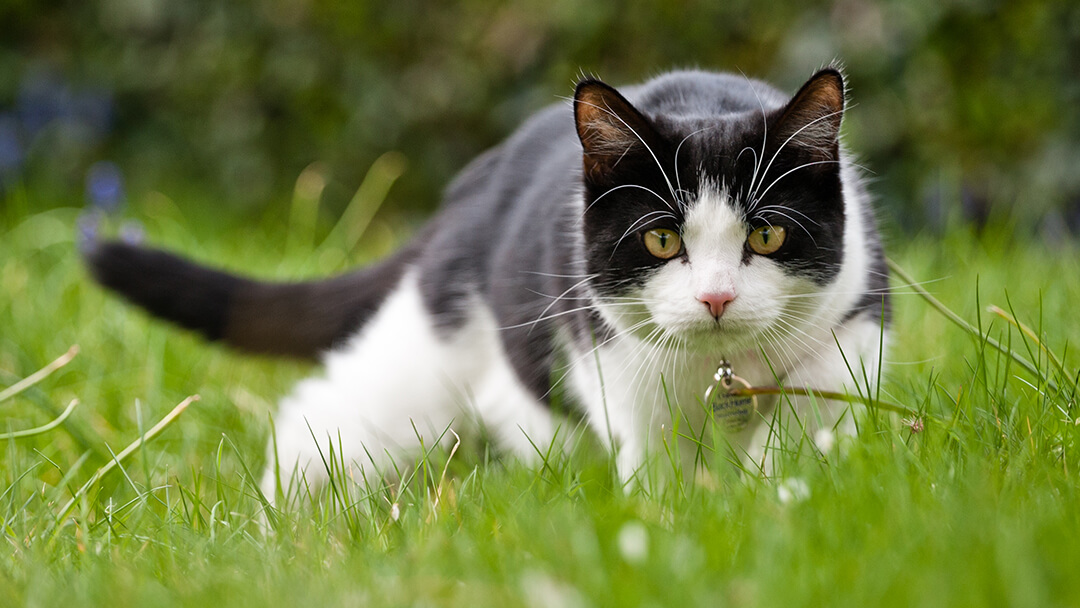
Most experienced cat owners can pick up on what their cat is trying to tell them through years of experience. Understanding cat body language can sometimes be challenging, though, even for long-time cat enthusiasts.

That doesn’t mean cats aren’t good communicators, though. Knowing what to look for can give you good insight into your cat’s emotions and help you create a closer bond, and that’s a win for everyone.
Cat Body Language
Cats primarily use three types of body language to communicate how they’re feeling: their tails, posture and ears. These three indicators are often the easiest for humans to inperpretinterpret. Here’s how to read your cat’s emotions through body language.
The Tail Has a Tale to Tell
Fortunately, when it comes to the body language of a cat, one of the most helpful indicators is also one of a cat’s most prominent features: its tail. There are times where just by looking at which way a cat’s tail is pointing or how it’s moving, you’ll get an excellent idea if they want to play, cuddle or just want some space to themself.
The meaning behind the five most common cat tail positions and movements:
- The question mark: Cats often position their tail in the shape of a question mark when they’re feeling playful. Time to grab a cat toy!
- Tail pointing straight up: This signifies a cat is feeling confident and ready to engage in some positive interaction.
- Tail wrapping: If a cat wraps their tail around another cat or a person, it’s a definite sign of affection, and it’s time to return the gesture by giving them a gentle scratch under the chin.
- A tucked away tail: This is a signal your cat might be feeling uncertain and fearful. Give them their space and evaluate what might be making your cat feel this way.
- A puffed-up tail: Unless it’s during play, when a cat does this, it’s either agitated or afraid. In this instance, step back, check for any stimuli that may be upsetting the cat and give them time to settle back down.
Keep an Eye on Cat Posture
While a cat’s tail can tell you a lot, it’s not the only nonverbal sign of how a cat might be feeling. There’s a lot of cat body language meaning in the posture cats display. Whether it’s crouching, an arched back or a purposeful, upright walk, cat posture can give important clues.
Five cat postures and their meanings:
- Stretched out: A cat laying stretched out on its side feels at ease and comfortable with their surroundings. In most cases, this is an excellent time to approach a cat and say hello.
- Upright and purposeful stride: This gait, usually accompanied by an upright tail, is the sign of a confident cat who’s feeling sociable.
- Crouched: A cat in a crouched position with their tail tucked under or close to their body may be feeling vulnerable and frightened.
- Arched back: Not to be confused with a stretch, this gesture is often accompanied by a curved and quickly swishing tail; this is a warning sign of an agitated cat who needs some alone time.
- Rolled slightly to the side: Not to be confused with the relaxed, stretched out position, cats will get tense and roll slightly to the side when feeling threatened. This position is often accompanied with tucked back ears, exposed teeth and the cat putting themself into a position to use their claws. This is a good indicator the cat must be left alone or the negative stimuli should be removed or a confrontation is imminent.
It’s All in the Ears
We’ve already covered two of the most obvious cat body language signals, but we’re not quite done because cats give a lot away by simply moving their ears. As a rule of thumb, how oriented towards the front of a cats face their ears are indicate how they’re feeling. Let’s look at what we can glean from something as simple as how a cat positions its ears.
Five cat ear positions and what they mean:
- Pointed forward, relaxed: This shows the cat feels relaxed, alert, confident and is paying close attention.
- Swiveling: When a cat swivels their ears, they’re trying to get the lowdown on the sights and sounds of their surroundings and is highly alert.
- Ears pointed to the side: This is an indicator that a cat may be feeling irritated by something in its vicinity.
- Flattened ears: When a cat’s ears do this, they’re afraid of something in the immediate vicinity. Stay vigilant and give cats their space if they do this.
- Ears pointing all the way back: Ears pointing all the way back and flattened against the head are a sure sign that a cat should not be approached. This cat may be feeling threatened by something or getting ready to fight or engage in other aggressive behaviors.
While the vocabulary of cat body language is long and filled with nuance, this is a good starting point in unlocking the language of cats. By learning to read your cat’s body language, you can tell if they seem frightened, angry, affectionate or playful. This way, cats will know you’re listening—or, more accurately, watching—and that you care.